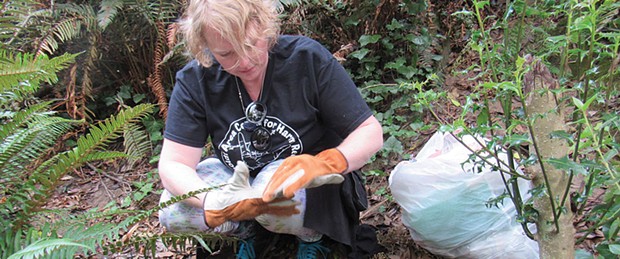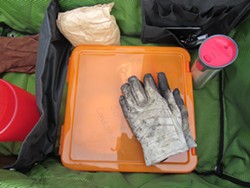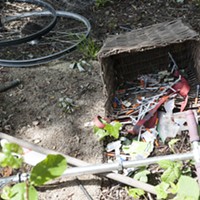The Sticking Point
Needle exchange gains renewed interest in Humboldt
By Linda Stansberry [email protected] @lcstansberry[
{
"name": "Top Stories Video Pair",
"insertPoint": "7",
"component": "17087298",
"parentWrapperClass": "fdn-ads-inline-content-block",
"requiredCountToDisplay": "1"
}
]
A newly approved spending bill that partially lifts the ban on federal funding to support needle-exchange programs may make 2016 the turning point for those trying to combat infectious disease in Humboldt County. The ban, originally lifted by the Obama administration in 2009 but reinstated by a Republican-controlled Congress in 2011, prevented federal money from going to programs that help intravenous drug users exchange their dirty needles for clean equipment.
This change, quietly inserted into the December spending bill by two Republican congressmen from heroin-ravaged Kentucky, will not pay for needles directly, but it will allow federal dollars to support the administrative costs and counseling in such programs. Needle exchange, a form of harm reduction, is a thorny issue as some believe the practice enables addicts, but the results of numerous studies are relatively unambiguous: Access to clean needles does not encourage drug use, and it helps reduce the spread of diseases such as HIV, hepatitis B and C.
Locally, Humboldt County rates fifth highest in the state for hepatitis C infections. The liver disease can be spread through sexual contact and passed from mother to child in utero, but the practice of sharing needles is the most common culprit in outbreaks. According to harm reduction advocates and local health providers, a vast number of carriers aren't even aware they have it.
"It's bigger than you think," says Brandie Wilson, founder of the Humboldt Area Center for Harm Reduction (HACHR). "The threat to public health is real, and the impact of harm reduction is real. For every dollar you spend on education, four dollars are saved in public health costs."
HACHR is in the process of setting up a peer syringe exchange, in which someone in the substance-using community carries clean needles and information into places where health workers might not have access or trust, such as homeless camps. The peer mentor will also carry a sharps container and help connect those interested in help with information about counseling and testing services. A local medical professional may serve as a liaison to order and dispose of needles. According to Wilson's research, one does not have to be a licensed needle exchange organization to provide clean syringes, as long as the number provided is less than 1,000 per day. It appears that HACHR's proposed peer exchange program may fit that criteria. The final step will be getting approval from the Eureka City Council. Mayor Frank Jager confirmed he will discuss putting it on the agenda with the city manager soon.
Locally, syringe exchange has had a checkered career. At present, there are only three entities actually handing clean needles to users and disposing of their used sharps: the county's North Coast AIDS Project, Redwoods Rural Health Center in Redway and United Indian Health Services' clinic in the lonely outpost of Weitchepec.
"Syringe exchange is an effective harm reduction strategy, but it is still viewed with suspicion by a number of people," says Mike Goldsby, former senior program manager at Humboldt County Human Services Department of Public Health. "Some apply the warped logic that providing these services actually causes the problem. Also, since syringe exchange serves a small segment of the population, it is typically a very low-profile service. So providers are hesitant to draw too much attention to syringe exchange."
A decade-long program offered through Open Door Health Services became a victim of its own success, suspending its 1-1 needle exchange in July 2009. In the year prior, the clinics exchanged a total of 183,754 needles. The program was well-utilized and the clients were "by and large, very respectful and considerate," says Sara Kerr, currently North Region administrator for the organization and former director of the needle exchange program. But the demand ultimately overwhelmed the capacity of the program, which paid an estimated $100,000 a year out of pocket for materials and staff time.
"It was a combination of things," she says. "Mostly competing space priorities. The program had gotten so large that we were literally getting flatbed truckloads of supplies delivered to clinic sites."
Because of the federal lock on funding, Open Door's needle exchange was dependent on some small local grants, and toward the end of the program the organization had largely shifted its focus towards family practice. Ultimately, Open Door decided the effort would be better met by the county's public health department, and NorCAP stepped in to at least partially fill the vacuum. But needle exchange is most effective when combined with complementary services, and no entity has quite reached the scale of Open Door since its program ended.
"We embrace the model of harm reduction," says Kerr. "It's a philosophy of meeting people where they're at. People have to stay alive in order to make a better choice tomorrow. We would refer lots of clients to our Suboxone program. We also offered an array of testing and case management to help with housing and food."
Down in Garberville, Tina Tvedt, executive director of Redwoods Rural Healthcare, says her program has a dedicated patient base of around 100 intraveneous drug users. The service, which is completely confidential, has allowed clinicians to make contact with clients who would otherwise go untested. Wilson and others believe if more users were given access to testing, the already high rate of hepatitis in the region would skyrocket due to better data.
"We do have a number of clients who have tested positive," says Tvedt. "There is medication that can completely reverse and cure it. We have also gotten clients into rehab, if that's what they want."
Some harm reduction advocates are skeptical as to whether or not the new ease on federal funding will actually help rural areas. Traditionally, funding is allocated toward areas with the most demand. With its relatively small population, Humboldt County may not fit the profile as a hepatitis "hot spot," but Wilson hopes the staggering number of people impacted by addiction and overdoses in our area will "raise some eyebrows."
"I think our data is alarming enough," she says.
Ray Grossveld, psychiatric care coordinator at Open Door's Suboxone program, which offers pharmaceutical support and counseling to opiate addicts, agrees that the problem is an "epidemic." He and the other staff in the Suboxone program try hard to keep pregnant mothers in the program and away from heroin.
"Every 19 minutes in the U.S. there's a baby born addicted to opiates," he says. "Those little ones in utero, they are our prime focus. If there's one person we can help, we bend over backwards to help that baby not be ... experiencing opiate withdrawal."
Grossveld adds that the rate of acute infections such as endocarditis have "skyrocketed" over the last few years. Many users begin with prescription opiates and then transition to heroin, and the time lapse between these two methods of transition has grown smaller and smaller.
"The age groups have gone much younger," he says. "The needle stigmatism is not there anymore, people will jump the needle a lot faster."
This, Wilson says, is why it's important to take the first step of making sure those injecting heroin or other drugs don't exacerbate what is already a public health crisis by sharing dirty needles. She recently caught wind of a homeless camp where eight people were sharing the same needle. One visit from a peer counselor might save several lives.
"Every little victory feels like the best victory ever," says Wilson.
For more about addiction on the North Coast, see our two-part series, "What's Killing Us?" (Sept. 10, 2015) and "Can Humboldt County Solve Addiction?" (Sept. 24, 2015).
more from the author
-
Lobster Girl Finds the Beat
- Nov 9, 2023
-
Tales from the CryptTok
- Oct 26, 2023
- More »
Latest in News
Readers also liked…
-
Through Mark Larson's Lens
A local photographer's favorite images of 2022 in Humboldt
- Jan 5, 2023
-
'To Celebrate Our Sovereignty'
Yurok Tribe to host gathering honoring 'ultimate river warrior' on the anniversary of the U.S. Supreme Court ruling that changed everything
- Jun 8, 2023




































